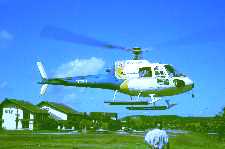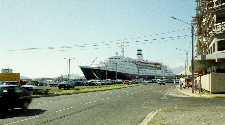Poised over Noumea |

The driver of our minibus made a detour out of the car park with the arrows
firmly against us.
"Of course since this is French territory we drive on the right."
He said as he steered to the left of the road.
I felt it did not augur well our ride in a helicopter. I hoped the rotors
would go round the right way. There was a short cut to the pad over a dirt track
that bypassed the roadway. It was just as well. It was safer but bumpy.
We were to fly over Noumea, the capital of New Caledonia. This South
Pacific Island was discovered by Captain Cook in 1774 but became French in 1853
under Napoleon III. It is now a French overseas territory administered by a High
Commissioner. In fact the territory comprises a group of islands known as Le
Grande Terre. It is encircled by an 800 Kilometre long coral reef, which
encloses the largest lagoon in the world. Of the population of 160,000, 74,000
are Melanesians and 55,000 are European.
With temperatures ranging up to 95 degrees F in the summer we were glad it
was only 77 degrees for our visit to this semi-tropical island, sometimes known
as the Paris of the Pacific. The sea breeze was welcome. On the East Coast the
vegetation is tropical and lush. It is separated from the drier West Coast by a
central mountain range.
The helicopter seated five people. Taking off from the harbour wall the
helicopter dipped downwards as it accelerated so that we faced the ground -
giving a splendid view of the town and bay. We left the Baie de la Moselle
behind and approached the marina with its multitude of yachts glistening in the
sun.
|

The water was in shades of blue for different depths and all so clear that
the bottom was easily seen. Beyond the reef were sharks but there inside the
reef, we were told, the water was too shallow and the fish too small to attract
them.
La Baie de Citrons was in front of us; a favourite bathing beach since it
is more sheltered from the prevailing wind than other beaches. Beyond it was the
aquarium, which harbours many varieties of fish, sea snakes and slugs. Nearby
were the handsome colonial houses situated along coconut palm bedecked
boulevards.
Soon it was time to change direction but we were less prepared for the
reverse manoeuvre. We became stationary, and our flying machine swung under its
rotor until we were looking up at the sky. Then we banked away and did a side
slip like fighter planes going in to the attack. The pilot grinned at the gasps
from his passengers. Sea and sky merged at 45 degrees to the new horizon as we
swept around in a circle and then in the upper right hand corner of the window
was the town with the traffic poised at a crazy angle.
We picked up speed rapidly and soon we were hovering over the Quartier
Latin. To one side was the bus station where numerous native buses would take
you to all parts of the town. Further afield were the mission stations, and the
Nickel mines which produce one third of the world's supply of Nickel, but there
was no time for that. We were expertly flown back to the launching pad, hovered
momentarily, and then we were down.
I always worry that a helicopter engine might stall. Perhaps I should have
worried more about the return trip on the wrong side of those French roads.
|
Helicopter.
The Marina - Baie de L'Orphelinat.
Baie de Citrons. | |
|
|



